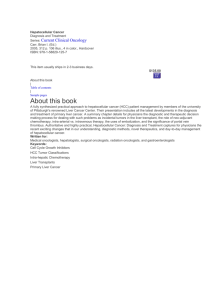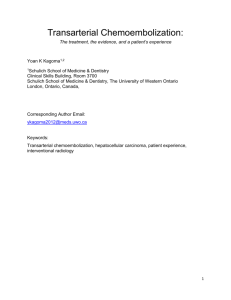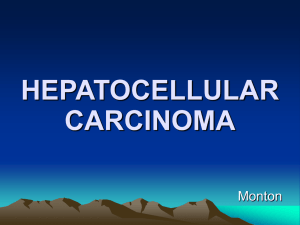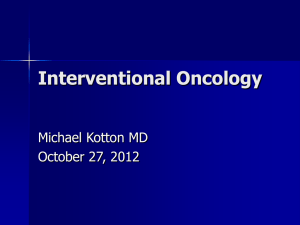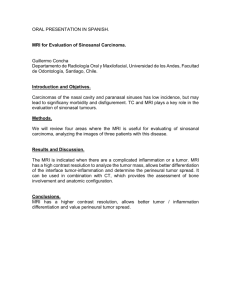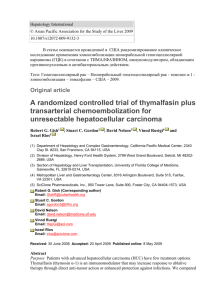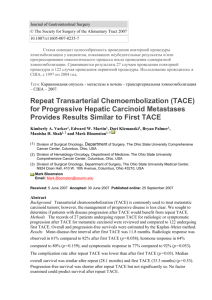European Radiology
advertisement
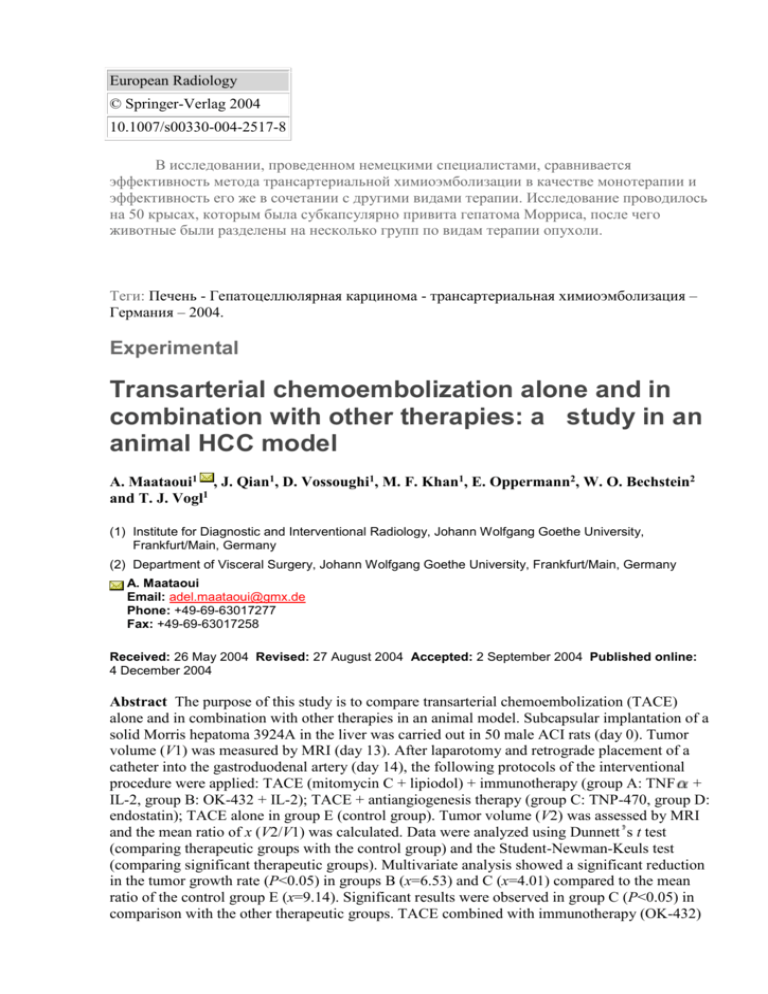
European Radiology © Springer-Verlag 2004 10.1007/s00330-004-2517-8 В исследовании, проведенном немецкими специалистами, сравнивается эффективность метода трансартериальной химиоэмболизации в качестве монотерапии и эффективность его же в сочетании с другими видами терапии. Исследование проводилось на 50 крысах, которым была субкапсулярно привита гепатома Морриса, после чего животные были разделены на несколько групп по видам терапии опухоли. Теги: Печень - Гепатоцеллюлярная карцинома - трансартериальная химиоэмболизация – Германия – 2004. Experimental Transarterial chemoembolization alone and in combination with other therapies: a study in an animal HCC model A. Maataoui1 , J. Qian1, D. Vossoughi1, M. F. Khan1, E. Oppermann2, W. O. Bechstein2 and T. J. Vogl1 (1) Institute for Diagnostic and Interventional Radiology, Johann Wolfgang Goethe University, Frankfurt/Main, Germany (2) Department of Visceral Surgery, Johann Wolfgang Goethe University, Frankfurt/Main, Germany A. Maataoui Email: adel.maataoui@gmx.de Phone: +49-69-63017277 Fax: +49-69-63017258 Received: 26 May 2004 Revised: 27 August 2004 Accepted: 2 September 2004 Published online: 4 December 2004 Abstract The purpose of this study is to compare transarterial chemoembolization (TACE) alone and in combination with other therapies in an animal model. Subcapsular implantation of a solid Morris hepatoma 3924A in the liver was carried out in 50 male ACI rats (day 0). Tumor volume (V1) was measured by MRI (day 13). After laparotomy and retrograde placement of a catheter into the gastroduodenal artery (day 14), the following protocols of the interventional procedure were applied: TACE (mitomycin C + lipiodol) + immunotherapy (group A: TNF + IL-2, group B: OK-432 + IL-2); TACE + antiangiogenesis therapy (group C: TNP-470, group D: endostatin); TACE alone in group E (control group). Tumor volume (V2) was assessed by MRI and the mean ratio of x (V2/V1) was calculated. Data were analyzed using Dunnett s t test (comparing therapeutic groups with the control group) and the Student-Newman-Keuls test (comparing significant therapeutic groups). Multivariate analysis showed a significant reduction in the tumor growth rate (P<0.05) in groups B (x=6.53) and C (x=4.01) compared to the mean ratio of the control group E (x=9.14). Significant results were observed in group C (P<0.05) in comparison with the other therapeutic groups. TACE combined with immunotherapy (OK-432) and antiangiogenesis therapy (TNP-470) retards tumor growth compared with TACE alone in an HCC animal model. Keywords Liver - Hepatocellular carcinoma - Transarterial chemoembolization The first two authors contributed equally to this publication. Introduction Hepatocellular carcinoma (HCC) is one of the most common malignancies worldwide, responsible for an estimated 1 million deaths annually and carrying a poor prognosis due to its rapid infiltrating growth and complicating liver cirrhosis [1]. To date, surgical approaches including liver resection and liver transplantation are regarded as potentially curative treatments for HCC, particularly in patients with small and non-invasive tumors [2]. However, only a small minority of patients are suitable for surgical therapy due to multicentric tumors, extrahepatic metastases, early vascular invasion, shortage of donor organs, high complication rates and comorbidities [3–5]. Local methods of tumor ablation, which include transarterial chemoembolization (TACE), percutaneous ethanol injection (PEI), radiofrequency ablation (RFA) [6–8], microwave coagulation therapy (MCT) and laser-induced thermotherapy (LITT), are promising additional tumor therapies, especially in patients with limited liver function and unresectable or multifocal tumors [9]. Since TACE was introduced as a palliative treatment in patients with unresectable HCC, it has become one of the most common forms of interventional therapies [10–12]. TACE has been shown to reduce systemic toxicity, increase local effects and thus improve the therapeutic results [11]. Its therapeutic effect is limited by the lack of appropriate and reliable embolic agents in those patients when the tumor is infiltrative in nature or hypovascular [13]. In the past years, locoregional immunotherapy and antiangiogenesis therapy for treating unresectable HCC have been reported with encouraging results, especially for inhibiting intrahepatic metastases and the recurrence of HCC [14–16]. Such adjuvant treatments in conjunction with TACE have the potential to enhance the therapeutic effect of TACE alone. However, there have been few randomized experimental studies to assess the value of these combined therapies in an animal model of HCC up to now. Thus, the purpose of our study was to compare TACE alone and in combination with other therapies in an animal HCC model. Material and methods Animal model Morris hepatoma 3924A, a rapidly growing, poorly differentiated hepatocellular carcinoma, was used in ACI rats in this study. The hepatoma specimen was obtained from the German Cancer Research Center (DKFZ; Heidelberg, Germany). Fifty inbred male ACI rats (Harlan Winkelmann; Borchen, Germany) weighing 220–260 g were used. The animals were kept under conventional conditions at a temperature of 22±2°C, a relative humidity of 55±10% and a dark/light rhythm of 12 h, and they were fed standard laboratory chow and tap water ad libitum. All of the experiments on animals were approved by the German government and the institutional animal research review board. Agents Locoregional immunotherapeutic agents TNF (tumor necrosis factor) is known to have various biological activities as a main inflammatory mediator and major initiator of a cytokine network, but most clinical attempts to use TNF as an antitumor drug in phase I trials have failed to date. A dose of 7.5 g TNF (Sigma-Aldrich Chemical GmbH, Munich, Germany) was dissolved in 0.5 ml 0.9% NaCl solution 20 min before application. OK-432 (Picibanil), an antitumor reagent prepared from Streptococcus pyogenes (Chugai Pharmaceutical Co., Tokyo, Japan) was administered at a dose of 0.05 mg OK-432, which was dissolved in 0.5 ml 0.9% NaCl solution 20 min before application. IL-2 (Interleukin-2) has been known to be a powerful drug for treating cancer by various immunological mediations. A dose of 5×103IU IL-2 (Sigma-Aldrich Chemical GmbH, Munich, Germany) was dissolved in 0.5 ml 0.9% NaCl solution 20 min before application. Antiangiogenesis agents Endostatin is a cleavage product of collagen XVIII that inhibits tumor angiogenesis and growth in mice. A dose of 0.8 mg endostatin (Calbiochem Company, Darmstadt, Germany) was suspended in 0.5 ml 0.9% NaCl solution plus 0.05 ml 10% ethanol 10 min before administration. TNP-470 (AGM-1470), a synthetic analog of fumagillin, a natural product of Aspergillus fumigatus, can selectively inhibit endothelial proliferation, with a subsequent antitumor effect. A dose of 5.0 mg TNP-470 (Takeda Chemical Company, Osaka, Japan) was suspended in 1.0 ml citrate-phosphate buffer (pH 6.2) 10 min before administration. Anesthesia The animals were anesthetized with intraperitoneal injection of ketamine hydrochloride, 100 mg·kg–1 (Ketanest, Parke-Davis, Heidelberg, Germany) and xylazinhydrochloride, 15 mg·kg–1 (Rompun, Bayer, Heidelberg, Germany) in all interventional and imaging procedures. Tumor implantation (day 0) The technique for tumor implantation was basically similar to that described by Yang et al. [17] with minor modifications [18]. The Morris hepatoma 3924A tumor tissue, recovered from a rat 2 weeks after subcutaneous implantation (corresponding to 5×106 tumor cells), was cut into small cubes about 2 mm3. A small subcapsular incision on the left lateral lobe of the liver was made in the recipient ACI rats under anesthesia. The tumor fragment was gently placed into the pocket with a small cotton swab on the liver surface, and the abdominal wall was then closed. Interventional therapy (day 14) A PE-10 polyethylene catheter (inner diameter 0.28 mm, outer diameter 0.61 mm; Wenzel; Heidelberg, Germany) was used for catheterization under laparotomy. By using a binocular operative microscope (M651, Leica; Wetzlar, Germany), the catheter was inserted retrogradely into the gastroduodenal artery and pushed forward to the common hepatic artery. Due to small hepatic artery branches no superselective embolization was possible. To ensure that the main agent flow was directed into the left hepatic artery, the right hepatic artery was always compressed manually. The mentioned agents were injected through the catheter to the hepatic artery by sandwich technique (subsequent injection of mitomycin—biotherapy—lipiodol) within 20 min. The placement of the catheter in the hepatic artery during the injection of the agents could be regarded as central embolization and prevented a reflux of the agents to the common hepatic artery and the coeliac trunk. Fifty rats were randomly assigned to one of the five groups (A–E), each comprising ten animals. All animals underwent transarterial chemoembolization (TACE), applying 0.1 mg mitomycin (Medac, Hamburg, Germany) and 0.1 ml lipiodol (Byk Gulden, Konstanz, Germany). In groups A and B, intraarterial immunotherapy was combined using TNF + IL-2 (group A) and OK-432 + IL-2 (group B). Antiangiogenesis therapy was combined using TNP-470 (group C) and endostatin (group D). The ten animals assigned to the control group E were treated only with TACE. MR imaging (day 13; day 27) and analysis Of the different imaging modalities for the examination of hepatocellular carcinomas [19–23], we decided to use magnetic resonance imaging. All studies were performed with a 1.5-T Sonata superconducting system (Siemens; Erlangen, Germany) using a wrist coil before (day 13) and after therapy (day 28). T1-weighted (SE: TR/TE, 460/15 ms) and T2-weighted (TSE: TR/TE, 3,170/99 ms) transverse images with a section thickness of 2 mm and 184×256 matrix were acquired. The images were interpreted regarding tumor size, tumor necrosis and the development of intrahepatic, metastatic lesions by two radiologists. There was no gap between sections, and no contrast medium was administered. The tumor volume was determined and evaluated in T2weighted image according to the following formula [24]: Statistical analysis The mean growth ratio of V2/V1 was analyzed by using Dunnett s t test (SAS-Software, USA), for comparing the effect of each therapeutic group with the control group. Comparisons between significant therapeutic groups were performed using the Student-Neuman-Keuls (SAS-Software, USA), test. P <0.05 was accepted as significant. Results Tumor implantation The rate of tumor implantation reached 100%. None of the animals died during implantation or interventional therapy. A total of 50 individual HCC tumors were seen with unenhanced MR imaging in the liver of 50 rats (100%) before treatment. The tumors grew in 50 of 50 rats (100%) after interventional treatment. MR imaging and analysis Due to the slice thickness of 2 mm, taking account of the small tumor volume, the presented imaging technique faces limitations. The differentiation of the tumor from the surrounding liver tissue was judged as sufficient by the interpreting radiologists from different signal intensities. The mean ratio of V2/V1 was 7.30 in group A, 6.53 in group B, 4.01 in group C, 7.78 in group D and 9.14 in group E. Compared to the control group E (TACE alone), groups B (TACE + OK432 + IL-2) and C (TACE + TNP-470) showed a significant decrease in the tumor growth ratio (P<0.05) using multivariate analysis (Dunnett s t test), while groups A (TACE + TNF + IL-2) and D (TACE + endostatin) did not (P>0.05). Significant results were observed in group C (P<0.05) in comparison with the other therapeutic groups using the Student-Newman–Keuls test. Intrahepatic metastasis occurred in one of ten rats in groups A and D and two of ten rats in group E (Fig. 1). Hypodense areas in the T2-weighted images, which are probably presented by intratumoral necrosis, occurred in one of ten rats in groups A, B, D and E, and two of ten rats in group C (Fig. 2) (Table 1). Fig. 1 Images in an ACI rat with a solid HCC in group E. a Pretherapeutic unenhanced T2-weighted axial MR imaging with TSE sequence (3,170/99). The hyperintense lesion with a size of 0.49×0.46 mm2 (arrow) is well discernible from the surrounding liver tissue. b Post-therapeutic unenhanced T2-weighted axial MR imaging with TSE sequence (3,170/99). The tumor with a size of 0.96×0.96 mm2 has a rapid growth compared with that before therapy. It also shows an inhomogeneous hyperintense area (arrow) corresponding to the intrahepatic metastasis Fig. 2 Images in an ACI rat with a solid HCC in group C. a Pretherapeutic unenhanced T2-weighted axial MR imaging with TSE sequence (3,170/99). The hyperintense lesion with a size of 0.41×0.40 mm2 (arrow) is well discernible from the surrounding liver tissue. b Post-therapeutic unenhanced T2-weighted axial MR imaging with TSE sequence (3,170/99). It shows the hyperintense lesion (0.73×0.71 mm2; arrow) with central hypointense area corresponding to the intratumoral necrosis Table 1 The tumor volume rate (V2/V1) in different groups (n=50) Rat no. 1 Group A (TNF ) 5.98 Group B (OK- Group C (TNP- Group D 432) 470) (endostatin) 8.79 3.55 8.22 Group E (control) 5.63 2 9.84a b 7.33 7.72 9.51 4.38 b 3 7.97 5.24 5.61 7.14 10.51b 4 6.77 5.59 3.01 5.49 7.74 5 9.96 6.06 3.87 6.29 8.64 Rat no. Group A (TNF ) Group B (OK- Group C (TNP- Group D 432) 470) (endostatin) Group E (control) 6 5.38 7.81b 5.75b 9.67 8.20 7 8.49 5.37 3.67 8.98 8.37 ab 8 6.02 5.47 3.72 10.01 8.54a 9 7.31 4.78 3.28 6.88 11.53 10 5.28 8.84 3.30 7.42 12.72a aTumor with intrahepatic metastasis. necrosis. bIntratumoral Discussion Since TACE was introduced as a palliative treatment in patients with unresectable HCC, it has become one of the most common forms of interventional therapies [10–12]. TACE with iodized oil has been shown to result in regression of HCC and reduction of systemic toxicity, thereby improving the therapeutic effects [11]. However, it remains questionable whether the therapies prolong patients overall survival [25]. It is well known that an improvement in the overall therapeutic effects of liver malignancies depends on the combined therapies [26–28]. However, few experimental or clinic reports have been published about the combination of TACE with biotherapy. Therefore, our present study was performed to determine the value of combining TACE with targeting locoregional immunotherapy and antiangiogenesis therapy versus TACE alone by MRI in the rat model of Morris hepatoma 3924A. This model was demonstrated as similar to hepatocellular carcinoma in humans and was superior to the tumor models of Walker-256 or VX-2 [29]. OK-432 can augment the antitumor effect of mitomycin, because OK-432 itself has a direct cytotoxic and cytostatic activity against tumor cells. Chemotherapy can also increase the susceptibility of tumor cells to cytotoxic effector s cells, including lymphocytes, macrophages and neutrophils activated by OK-432 through direct damage or modulation of surface antigens by chemotherapy [30]. In addition, mitomycin can eliminate the suppressor cells or suppressor factor in the blood or effusion, resulting in augmented anticancer activity of OK-432-activated immunopotentiating cells, especially T-cells [31, 32]. It was also proven by histological examination that transarterial immunoembolization (TIE) seems to be more effective than conventional TAE for the therapy of extracapsular invasion and prevention of intrahepatic metastases in humans [14, 33]. Okuno et al. found that hepatic infusion of IL-2 can increase the permeability of the hepatic endothelium, resulting in an increase of hepatic extraction of antitumor agents [34]. This effect may improve the delivery of antitumor drugs to the liver, thereby reducing the systemic drugassociated toxicity [35]. Our approach of immuno-chemoembolization was based on the abovementioned reports showing the value of TIE and locoregional immunochemotherapy. The results showed a significant reduction of the tumor growth rate by OK-432 plus TACE compared with TACE alone. No intrahepatic metastasis was observed. In our experiments, OK-432 seems to exert its more potent antitumor effects in TACE. TNF , another biological response modifier, has a variety of biological activities in vitro, such as cytotoxic activity to cancer cells, damage to endothelial cells and enhancement of fibroblast proliferation [36]. Watanabe et al. found that the intraarterial infusion of TNF /lipiodol emulsion may produce prominent antitumor effects in rabbits, possibly due to the higher concentration and prolonged retention of TNF in the tumors, which causes damage to the endothelium of the tumor vessels [36]. In the experimental study of Yang et al., it was indicated that tumor growth is significantly retarded by continuous hepatic infusion of TNF plus ligation of the hepatic artery in ACI rats [37]. In this respect the placement of a catheter in the hepatic artery for a substantial period could be regarded as central embolization of the tumor vessel. Our study design was limited by the long-term placement of the catheter in the hepatic artery, and for this reason, a lower total dose of TNF combined with IL-2 was transarterially injected in the liver tumor in comparison with the study of Yang et al. This could be an explanation why the single combined therapy of TNF + TACE did not induce a significant reduction in the tumor growth. Antiangiogenic agents have low toxicity due to their selective effect on tumor vasculature; their combination with anticancer agents may potentiate their anticancer effects [38–40]. For the best clinical results, antiangiogenic therapy should be used in combination with other adjuvant therapies [41–43]. TNP-470 inhibits proliferation and migration of endothelial cells and capillary tube formation at cytostatic but not cytotoxic concentrations. It is believed that ischaemic hypoxia and necrosis induced by TACE stimulates angiogenesis in the residual viable HCC [44]. Combination treatment in animals showed that TNP-470 potentiates the anticancer effects of some cytotoxic and biological agents [45], but the terminal plasma half-life of TNP-470 is short, and the drug is rapidly cleared from the circulation after a single 1-h infusion [46]. It was reported that TAE combined with TNP-470 may enhance the anticancer effect of TAE alone in the treatment of HCC without severe side effects on the liver or body weight gain [47, 48]. Our results indicated that the tumor growth ratio is markedly reduced by combined transarterial administration of TNP-470 and TACE compared with TACE alone (P<0.05). Its antitumor effect is stronger than that of the immunotherapy group (OK-432 + TACE and TNF + TACE). Endostatin, which was used as an angiogenesis inhibitor in our study, is a new kind of potent antiangiogenic factor [49]. Endostatin was shown to inhibit VEGF-induced endothelial cell migration in vitro and to have antitumor activity in vivo, without any apparent sign of toxicity [50]. It has also been reported that endostatin can inhibit the growth of transplantable HCC in nude mice by 52.2% [51], and the addition of endostatin to conventional chemotherapy enhances the antitumor effect in a murine model of early colorectal liver metastasis [52]. Our present results indicated that the selective delivery therapy of endostatin in conjunction with TACE has no significant advantage in stemming tumor growth compared with TACE alone. Intrahepatic metastases (10%) occurred in this group. We hypothesized that the availability of this therapy relates to the higher doses of citrate-phosphate buffer solution (1.0 ml), in which 0.8 mg endostatin can be dissolved. As a result, more mitomycin and lipiodol could perhaps be washed out from the tumor, and thus the antitumor effect was influenced. In summary, an encouraging result (significant reduction of tumor growth rate combining TACE with OK-432 and TNP-470 compared to TACE alone) was obtained by combining different locoregional therapies with TACE for treating HCC in rats in comparison with TACE alone and may prove valuable to human application as a therapeutic approach for the treatment of HCC. However, detailed therapeutic mechanisms, therapeutic indications, monitoring and validation of these combined therapies still remain unclear and require more randomized animal experimental studies. Practical application Locoregional therapies including immune and antiangiogenesis therapy combined with TACE demonstrated an obvious reduction in tumor growth compared with TACE alone. These results may represent a first approach to an effective modulation of transarterial chemoembolization in the treatment of HCC for further clinical studies. References 1. Cha C, DeMatteo RP, Blumgart LH (2002) Surgery and ablative therapy for hepatocellular carcinoma. J Clin Gastroenterol 35(5 Suppl 2):S130–S137 2. Tang ZY (1998) Treatment of hepatocellular carcinoma. Digestion 59(5):556–562 3. Alsowmely AM, Hodgson HJ (2002) Non-surgical treatment of hepatocellular carcinoma. Aliment Pharmacol Ther 16(1):1–15 4. Durand F, Belghiti J (2002) Liver transplantation for hepatocellular carcinoma. Hepatogastroenterology 49(43):47–52 5. Poon RT et al (2002) Locoregional therapies for hepatocellular carcinoma: a critical review from the surgeon s perspective. Ann Surg 235(4):466–486 6. Denys AL et al (2003) Radio-frequency tissue ablation of the liver: in vivo and ex vivo experiments with four different systems. Eur Radiol 13(10):2346–2352 7. Lee JM et al (2004) Combined treatment of radiofrequency ablation and acetic acid injection: an in vivo feasibility study in rabbit liver. Eur Radiol 14(7):1303–1310 8. Buscarini E, Buscarini L (2004) Radiofrequency thermal ablation with expandable needle of focal liver malignancies: complication report. Eur Radiol 14(1):31–37 9. Sturm JW et al (2001) Locally ablative therapies of hepatocellular carcinoma. Onkologie 24(Suppl 5):35–45 10. Achenbach T et al (2002) Chemoembolization for primary liver cancer. Eur J Surg Oncol 28(1):37–41 11. Llovet JM et al (2002) Arterial embolisation or chemoembolisation versus symptomatic treatment in patients with unresectable hepatocellular carcinoma: a randomised controlled trial. Lancet 359(9319):1734–1739 12. Vogl TJ et al (2000) Transarterial chemoembolization for hepatocellular carcinoma: volumetric and morphologic CT criteria for assessment of prognosis and therapeutic success-results from a liver transplantation center. Radiology 214(2):349–357 13. Lin DY, Lin SM, Liaw YF (1997) Non-surgical treatment of hepatocellular carcinoma. J Gastroenterol Hepatol 12(9–10):S319–S328 14. Yoshida T et al (2001) Appraisal of transarterial immunoembolization for hepatocellular carcinoma: a clinicopathologic study. J Clin Gastroenterol 32(1):59–65 15. Mugitani T et al (1998) TNP-470 inhibits collateralization to complement the anti-tumour effect of hepatic artery ligation. Br J Cancer 77(4):638–642 16. Zheng C, Feng G, Liang H (1998) Bletilla striata as a vascular embolizing agent in interventional treatment of primary hepatic carcinoma. Chin Med J (Engl) 111(12):1060–1063 17. Yang R et al (1992) A reproducible rat liver cancer model for experimental therapy: introducing a technique of intrahepatic tumor implantation. J Surg Res 52(3):193–198 18. Trubenbach J et al (2000) Growth characteristics and imaging properties of the morris hepatoma 3924A in ACI rats: a suitable model for transarterial chemoembolization. Cardiovasc Intervent Radiol 23(3):211–217 19. Fournier LS et al (2004) Early modifications of hepatic perfusion measured by functional CT in a rat model of hepatocellular carcinoma using a blood pool contrast agent. Eur Radiol 14:2125-2133 20. Klein D et al (2004) Quantitative dynamic contrast-enhanced sonography of hepatic tumors. Eur Radiol 14(6):1082–1091 21. Nicolau C et al (2004) Evaluation of hepatocellular carcinoma using SonoVue, a second generation ultrasound contrast agent: correlation with cellular differentiation. Eur Radiol 14(6):1092–1099 22. Koda M et al (2004) Qualitative assessment of tumor vascularity in hepatocellular carcinoma by contrast-enhanced coded ultrasound: comparison with arterial phase of dynamic CT and conventional color/power Doppler ultrasound. Eur Radiol 14(6):1100–1108 23. Kwak HS, Lee JM, Kim CS (2004) Preoperative detection of hepatocellular carcinoma: comparison of combined contrast-enhanced MR imaging and combined CT during arterial portography and CT hepatic arteriography. Eur Radiol 14(3):447–457 24. Carlsson G, Gullberg B, Hafstrom L (1983) Estimation of liver tumor volume using different formulas— an experimental study in rats. J Cancer Res Clin Oncol 105(1):20–23 25. Choi BI et al (1992) Therapeutic effect of transcatheter oily chemoembolization therapy for encapsulated nodular hepatocellular carcinoma: CT and pathologic findings. Radiology 182(3):709– 713 26. Pacella CM et al (2001) Hepatocellular carcinoma: long-term results of combined treatment with laser thermal ablation and transcatheter arterial chemoembolization. Radiology 219(3):669–678 27. Koda M et al (2001) Combination therapy with transcatheter arterial chemoembolization and percutaneous ethanol injection compared with percutaneous ethanol injection alone for patients with small hepatocellular carcinoma: a randomized control study. Cancer 92(6):1516–1524 28. Bloomston M et al (2002) Transcatheter arterial chemoembolization with or without radiofrequency ablation in the management of patients with advanced hepatic malignancy. Am Surg 68(9):827–831 29. Qian J et al (2003) Application of poly-lactide-co-glycolide-microspheres in the transarterial chemoembolization in an animal model of hepatocellular carcinoma. World J Gastroenterol 9(1):94– 98 30. Uehara K et al (2002) Systemic administration of liposome-encapsulated OK-432 prolongs the survival of rats with hepatocellular carcinoma through the induction of IFN-gamma-producing hepatic lymphocytes. J Gastroenterol Hepatol 17(1):81–90 31. Nio Y et al (1999) Multi-institutional randomized clinical study on the comparative effects of intracavital chemotherapy alone versus immunotherapy alone versus immunochemotherapy for malignant effusion. Br J Cancer 80(5–6):775–785 32. Oka M et al (1994) Intraarterial combined immunochemotherapy for unresectable hepatocellular carcinoma: preliminary results. Cancer Immunol Immunother 38(3):194–200 33. Kanai T et al (1994) New development of transarterial immunoembolization (TIE) for therapy of hepatocellular carcinoma with intrahepatic metastases. Cancer Chemother Pharmacol 33(Suppl):S48–S54 34. Okuno K et al (1996) IL-2 perfusion to the liver augments the hepatic extraction rate of accompanying anticancer drugs. Surg Today 26(8):662–664 35. Okuno K et al (1999) Intrahepatic interleukin-2 with chemotherapy for unresectable liver metastases: a randomized multicenter trial. Hepatogastroenterology 46(26):1116–1121 36. Watanabe D et al (1995) Antitumor effects of intraarterial infusion of tumor necrosis factor/lipiodol emulsion on hepatic tumor in rabbits. Oncology 52(1):76–81 37. Yang R et al (1995) Experimental liver cancer: improved response after hepatic artery ligation and infusion of tumor necrosis factor-alpha and interferon-gamma. Surgery 118(4):768–72 (discussion 772–774) 38. Westphal JR, Ruiter DJ, De Waal RM (2000) Anti-angiogenic treatment of human cancer: pitfalls and promises. Int J Cancer 86(6):870–873 39. Keshet E, Ben-Sasson SA (1999) Anticancer drug targets: approaching angiogenesis. J Clin Invest 104(11):1497–1501 40. Tomanek RJ, Schatteman GC (2000) Angiogenesis: new insights and therapeutic potential. Anat Rec 261(3):126–135 41. Folkman J (1996) New perspectives in clinical oncology from angiogenesis research. Eur J Cancer 32A(14):2534–2539 42. Drixler TA et al (2000) Angiogenesis and surgery: from mice to man. Eur J Surg 166(6):435–446 43. O Reilly MS (2002) The combination of antiangiogenic therapy with other modalities. Cancer J 8(Suppl 1):S89–S99 44. Kim YB, Park YN, Park C (2001) Increased proliferation activities of vascular endothelial cells and tumour cells in residual hepatocellular carcinoma following transcatheter arterial embolization. Histopathology 38(2):160–166 45. Ogawa H et al (2000) Combined treatment with TNP-470 and 5-fluorouracil effectively inhibits growth of murine colon cancer cells in vitro and liver metastasis in vivo. Oncol Rep 7(3):467–472 46. Figg WD et al (1997) The pharmacokinetics of TNP-470, a new angiogenesis inhibitor. Pharmacotherapy 17(1):91–97 47. Yanai S et al (1995) Antitumor effect of arterial administration of a medium-chain triglyceride solution of an angiogenesis inhibitor, TNP-470, in rabbits bearing VX-2 carcinoma. Pharm Res 12(5):653–657 48. Yanai S et al (1994) Antitumor activity of a medium-chain triglyceride solution of the angiogenesis inhibitor TNP-470 (AGM-1470) when administered via the hepatic artery to rats bearing Walker 256 carcinosarcoma in the liver. J Pharmacol Exp Ther 271(3):1267–1273 49. Wang X et al (2002) Inhibitory effect of endostatin expressed by human liver carcinoma SMMC7721 on endothelial cell proliferation in vitro. World J Gastroenterol 8(2):253–257 50. O Reilly MS et al (1997) Endostatin: an endogenous inhibitor of angiogenesis and tumor growth. Cell 88(2):277–285 51. Jiang YF, Yang ZH, JQ Hu (2000) Recurrence or metastasis of HCC: predictors, early detection and experimental antiangiogenic therapy. World J Gastroenterol 6(1):61–65 52. te Velde EA et al (2002) Enhanced antitumour efficacy by combining conventional chemotherapy with angiostatin or endostatin in a liver metastasis model. Br J Surg 89(10):1302–1309
